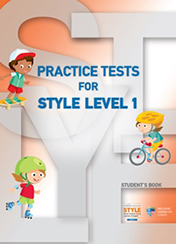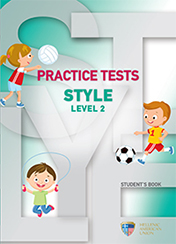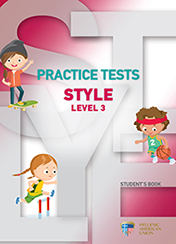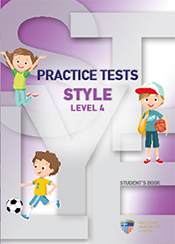The School Tests for Young Learners of English (STYLE) are designed for young learners aged 7-12 who would like an objective assessment of their competency in English as a second or other language at the elementary level. The STYLE tests are aimed at the A1 and A2 levels of the Common European Framework of Reference (CEFR).
STYLE Level 1 is aimed at the A1 level of the Common European Framework of Reference (CEFR) designed for young learners who would like an objective assessment of their competency in English as a second or other language at the beginners’ level. STYLE Level 2 is aimed to bridge the A1 and A2 levels of CEFR designed for young learners who would like an objective assessment of their competency in English as a second or other language at the elementary level. STYLE Level 3 is aimed at the A2 level of the CEFR, and STYLE Level 4 is aimed at the high end of the A2 level of the CEFR.
All tests are specifically designed to be stimulating and motivating for young learners through the use of age-appropriate tasks, pictures and layout.
The STYLE are developed and scored by Hellenic American University, a non-profit institution of higher education chartered in the state of New Hampshire, USA, in cooperation with external experts and bodies both in Europe and the United States. All parts of the examinations are written following specific guidelines and test specifications. Items are pre-tested to ensure standardization and validity. Care is taken that the tests are fair and accessible to all candidates.
Communicative competency in all four language skills is tested: reading, writing, listening, and speaking, as well as vocabulary and grammar resources.
Listening (20 questions) (20 marks)
Task 1 (5 items) 5 short dialogues heard twice with 1 question per dialogue – candidates match the person with the picture.
Task 2 (5 items) 1 dialogue heard twice – 5 short statements to which candidates choose True or False.
Task 3 (5 items) 1 dialogue heard twice – candidates complete 5 gaps in a very simple list.
Task 4 (5 items) 5 short dialogues heard twice with 1 question per dialogue and 3 picture answer choices per question.
Listening section duration: 20 min. (approx.)
Candidates write their answers in the test booklet using pen or pencil.
Reading & Use of Language (20 questions) (20 marks)
Task 1 (5 questions): 5 short sentences, each describing a picture – candidates choose whether each sentence is True or False.
Task 2 (5 questions): A story divided into 5 short texts, each with 1 question and 3 answer choices.
Task 3 (5 questions): 5 short dialogues, each with a gap – candidates choose the best answer from three answer choices.
Task 4 (5 questions): 5 pictures – with one question per picture, each with 3 possible answers – candidates choose the best answer according to the picture
Reading & Use of Language section duration: 25 min.
Candidates write their answers in the test booklet using pen or pencil.
Writing (2 tasks) (18 marks)
Task 1 (3-4 questions): 3-4 questions forming part of a dialogue. Candidates use the picture prompts to answer the questions in the dialogue using 1 or 2 sentences.
Task 2: (1 question): 1 question on the same topic as Task 1, to which candidates write a response.
Writing section duration: 20 min.
Candidates write their answers in the test booklet using pen or pencil.
Speaking (3 tasks) (9 marks)
Task 1: Answering personal questions.
Task 2: Understanding and providing information in an information gap activity between the candidates.
Task 3: Answering questions about the topic.
Speaking section duration: 5-7 min. (1 examiner-2 candidates)
General
The first three sections (Listening, Reading & Use of Language, and Writing) comprise the written part of the examination and they are all administered at the same day. The fourth section (Speaking) is administered before or after or even at the same day of the written examinations.
Listening (24 questions) (24 marks)
Task 1 (6 questions) 6 short dialogues heard twice with 1 question per dialogue – candidates match the person with the picture.
Task 2 (6 questions) 1 dialogue heard twice – 6 short statements to which candidates choose True or False.
Task 3 (6 questions) 1 dialogue heard twice with a description – candidates complete 6 gaps in a simple form.
Task 4 (6 questions) 6 short dialogues heard twice with 1 question per dialogue and 3 picture answer choices per question.
Listening section duration: 20 min. (approx.)
Candidates write their answers in the test booklet using pen or pencil.
Reading & Use of Language (25 questions) (25 marks)
Task 1 (4 questions): 1 short text with 4 multiple-choice questions, each with 4 answer choices.
Task 2 (5 questions): 3 short texts with 5 multiple-choice questions, each with 3 answer choices.
Task 3 (5 questions): 5 short sentences, each with a gap and 4 answer choices.
Task 4 (5 questions): 5 short sentences, each with a gap and 4 answer choices
Task 5 (3 questions): 3 short dialogues, each with 1 gap – candidates choose the correct option from a list.
Task 6 (3 questions): 1 dialogue with 3 gaps – candidates choose the correct option from a list.
Reading & Use of Language section duration: 25 min.
Candidates write their answers in the test booklet using pen or pencil.
Writing (2 tasks) (18 marks)
Task 1 (1 question): Providing personal information.
Task 2: (1 question): Writing a short text.
Writing section duration: 25 min.
Candidates write their answers in the test booklet using pen or pencil.
Speaking (4 tasks) (9 marks)
Task 1: Answering personal questions.
Task 2: Understanding and providing information in an information gap activity.
Task 3: Guided discussion in order to reach an agreement.
Task 4: Follow-up questions asking about preferences.
Speaking section duration: 5-7 min. (1 examiner-2 candidates)
General
The first three sections (Listening, Reading & Use of Language, and Writing) comprise the written part of the examination and they are all administered at the same day. The fourth section (Speaking) is administered before or after or even at the same day of the written examinations.
Listening (25 questions) (25 marks)
STYLE Level 3 tests communicative competency in all four language skills: reading, writing, listening, and speaking, as well as vocabulary and grammar resources.
Task 1 (5 questions) 5 short dialogues heard twice with 1 question per dialogue – candidates choose which picture the dialogue is about.
Task 2 (5 questions) 1 dialogue heard twice – 5 short statements to which candidates choose True or False.
Task 3 (5 questions) 5 dialogues heard twice – candidates use the information they hear to choose the correct answer choice from three short written options.
Task 4 (10 questions) 10 short dialogues heard twice with 1 question per dialogue and 3 picture answer choices per question.
Listening section duration: 25 min. (approx.)
Candidates must write their answers on the answer sheet provided using pencil. Extra time to transfer answers from the test booklet onto the answer sheet is given.
Reading & Use of Language (30 questions) (30 marks)
Task 1 (5 questions): 1 short text with 5 multiple-choice questions, each with 4 answer choices.
Task 2 (5 questions): 3 short texts with 5 multiple-choice questions, each with 3 answer choices.
Task 3 (5 questions): 5 short sentences, each with a gap and 4 answer choices.
Task 4 (5 questions): 5 short sentences, each with a gap and 4 answer choices
Task 5 (5 questions): 1 dialogue with 5 gaps – candidates choose the correct option from three answer choices.
Task 6 (5 questions): 1 text with 5 gaps – candidates choose the correct option from three answer choices.
Reading & Use of Language section duration: 35 min.
Candidates must write their answers on the answer sheet provided using pencil. Extra time to transfer answers from the test booklet onto the answer sheet is not given.
Writing (2 tasks) (18 marks)
Task 1 (1 question): Providing personal information.
Task 2: (1 question): Writing a short text.
Writing section duration: 25 min.
Candidates write their answers in the test booklet using pen or pencil.
Speaking (4 tasks) (9 marks)
Task 1: Answering personal questions.
Task 2: Understanding and providing information in an information gap activity.
Task 3: Guided discussion in order to reach an agreement.
Task 4: Follow-up questions asking about preferences.
Speaking section duration: 7-9 min. (1 examiner-2 candidates)
General
The first three sections (Listening, Reading & Use of Language, and Writing) comprise the written part of the examination and they are all administered at the same day. The fourth section (Speaking) is administered before or after or even at the same day of the written examinations.
Listening (25 questions) (25 marks)
Task 1 (5 questions) 5 short dialogues heard twice with 1 question per dialogue – candidates choose which picture the dialogue is about.
Task 2 (5 questions) 1 dialogue heard twice – 5 short statements to which candidates choose True or False.
Task 3 (5 questions) 1 long conversation heard twice – candidates use the information they hear to choose the correct answer choice from three short written options.
Task 4 (10 questions) 10 short dialogues heard twice with 1 question per dialogue and 3 picture answer choices per question.
Listening section duration: 25 min. (approx.)
Candidates must write their answers on the answer sheet provided using pencil. Extra time to transfer answers from the test booklet onto the answer sheet is given.
Reading & Use of Language (40 questions) (40 marks)
Task 1 (5 questions): 1 short text with 5 multiple-choice questions, each with 4 answer choices.
Task 2 (5 questions): 3 short texts with 5 multiple-choice questions, each with 3 answer choices.
Task 3 (10 questions): 10 short sentences, each with a gap and 4 answer choices.
Task 4 (10 questions): 10 short sentences, each with a gap and 4 answer choices
Task 5 (5 questions): 1 dialogue with 5 gaps – candidates choose the correct option from three answer choices.
Task 6 (5 questions): 1 text with 5 gaps – candidates choose the correct option from three answer choices.
Reading & Use of Language section duration: 40 min.
Candidates must write their answers on the answer sheet provided using pencil. Extra time to transfer answers from the test booklet onto the answer sheet is not given.
Writing (2 tasks) (18 marks)
Task 1 (1 question): Providing personal information.
Task 2: (1 question): Writing a short text.
Writing section duration: 25 min.
Candidates write their answers in the test booklet using pen or pencil.
Speaking (4 tasks) (9 marks)
Task 1: Answering personal questions.
Task 2: Understanding and providing information in an information gap activity.
Task 3: Guided discussion in order to reach an agreement.
Task 4: Follow-up questions asking about preferences.
Speaking section duration: 7-9 min. (1 examiner-2 candidates)
General
The first three sections (Listening, Reading & Use of Language, and Writing) comprise the written part of the examination and they are all administered at the same day. The fourth section (Speaking) is administered before or after or even at the same day of the written examinations.
Register online for your exams through ORFEAS, our online registration system. Find an examination center close to home from a choice of 100 locations throughout Greece and abroad, and complete your application online with your debit, pre-paid or credit card.
You will receive all the details for your upcoming exam via email in a single document that you can save, print and take with you on the day of your test. You will also be sent updates on the status of your application and useful support materials. Expect invitations to webinars for tips and strategies that will help you prepare effectively for the exam.
The ORFEAS registration system does away with print application forms and visits to the bank. Start and complete your registration online in a few simple steps. Use your home computer, tablet or smartphone to apply for your exam.
Hellenic American University provides the opportunity to secure nonstandard test accommodations for candidates with disabilities and/or learning difficulties. For detailed information regarding the types of special accommodations offered, the required medical documentation, as well as the request submission process, please visit the Hellenic American University’s Nonstandard Test Accommodations page.
The results of STYLE 1-4 are given for each of the four sections: Listening, Reading and Use of Language, Writing, and Speaking. Candidates receive a scaled score for each section expressed as a number of dolphins between one and five, with one dolphin as the lowest scoring result and five dolphins as the highest scoring result.
There is no ‘pass’ or ‘fail’ for the test and no overall score given. Candidates who receive a result of three, four, or five dolphins for the four sections on the test are considered to be ready to proceed to the next level.
The Writing Section
The Writing Section is scored out of a total of nine marks for each task. There are three criteria: Task Completion, Organization, and Linguistic Resources..
The number of marks from the two tasks is added together to give a total score out of eighteen. Candidates receive between one and five dolphins which shows their scale-score achievement for the Writing Section.
The raters have been trained and certified according to Hellenic American University standards.
The Speaking Section
The Speaking Section is scored out of a total of nine marks. There are three criteria: Task Completion, Fluency and Interaction, and Linguistic Resources.
The number of marks is added together to give a total score out of nine. Candidates receive between one and five dolphins which shows their scale-score achievement for the Speaking Section.
The oral examiners have been trained and certified according to Hellenic American University standards.
Results
The results for the STYLE examination will be available on our website approximately six weeks after the completion of the exam period.
Results and Certificates Services
Discover our available results and certificates services. Learn how you can request, among other things, the rescoring of your test, the notarization of a copy of a certificate, and the issuance of a certification of loss of a certificate.
How do I sign up for Orfeas?
If you are an individual candidate:
- Visit the Hellenic American Union website.
- Navigate to “Sign In”.
- Then select “Register” and fill in your personal information.
- You will receive an automated e-mail with a link to verify your account and complete the registration.
- Click on the link and fill in your username and password. Finally, select “Sign In” to complete the registration process.
If you are a teacher or a Foreign Language School owner:
- Visit the Hellenic American Union website and complete the form with your personal and/or business information, and upload the required documents.*
Please note: You will be asked to provide an email address to register for Orfeas. This address, as well as the optional secondary email address should not have been used previously to create an Orfeas account or register as an individual candidate.
- Select “Save”.
- You will receive an automated e-mail with a link to verify your account and complete the registration.
- We will process your request, and e-mail you with a temporary password for first-time access. After that, you will be asked to change your password.
*Acceptable documents (max 5 MB):
For teachers (one of the following):
- Proficiency in English certificate
- Degree from a foreign university with English as the language of instruction
- English Language and/or Literature degree
- Renewal of teaching license
- Certificate of commencement of teaching profession
- CELTA (Certificate in Teaching English to Speakers of Other Languages)
- DELTA (Diploma in Teaching English to Speakers of Other Languages)
- English Literature document of final year studies
For Foreign Language Schools (one of the following):
- Business registry details from the Independent Authority for Public Revenue (ΑΑΔΕ)
- Certificate of commencement of activity for individual entrepreneurs
- Certificate from the General Commercial Registry (ΓΕΜΗ)
- Company stamp
- Certification from the Organization for Certification of Qualifications & Professional Orientation (ΕΟΠΠΕΠ)
Please note that this step is required to register yourself or your students for your chosen exams at a later time.
How can I order your books?
You can place your order in the following ways:
- Completing an order form through the online store of our educational publications.
- Sending an e-mail to publications@hau.gr or calling +2103680000, option 2. Be sure to include your full name, address, Hellenic American Union collaboration number, and email address (if you have called to place your order).
Please note: Orders over €20.00 are sent free of charge; otherwise, a delivery fee of €5.00 applies.
How can I register for the certificate exams of my choice?
For Foreign Language Schools owners and teachers:
- After logging into Orfeas with your e-mail and password, select the “Applications/Registrations” section. You will be automatically redirected to the “My Students” tab.
- If this is your first time registering a student, select “New Student”, fill in their personal details (using all Roman capital letters, exactly as they appear on their ID or passport), and click “Save”. If the student has already been registered, you can find them in your student list.
- Select the checkbox next to the candidate’s name (or select multiple boxes if you wish to register multiple candidates for the same exam). Then, click “Register Students”.
- When the pop-up window appears, follow the on-screen instructions. Click “Submit”, and you will be automatically directed to the “My Exams” tab.
- You will see the new group of students for registration. Click “Pay & Submit” to choose your payment method and to finalize your application.
For Individual Candidates:
- After logging into Orfeas with your e-mail and password, go to the “Registration” section.
- Enter your personal details using Roman capital letters, exactly as they appear on your ID or passport.
- Read and accept the terms and conditions, then click “Save”.
- You will be automatically redirected to “My Exams”. Select “New Application” from the top right.
- Follow the on-screen instructions, and click on “Submit” to review your application, and click “Pay & Submit” to complete the process.
How do I pay the examination fee?
To pay the examination fee, you must first complete the registration and application for your chosen exam.
Available payment options:
- Credit Card
- IRIS
- Reference Code
To make a payment using the Reference Code, please follow these steps:
- Use e-banking or phone banking through your bank.
- Select “HELLENIC AMERICAN UNION” in the “Payments” field.
- Select the fee amount specified in the confirmation email you received after registration. You may also optionally enter the candidate’s full name in the “Payment Description/Details” field. Please kindly note that the payment may be processed within up to 3 working days from the date of deposit.
Can I delete my application or my student’s application?
According to exam regulation 4.12., the examination fees paid are non-transferable and non-refundable. If you notice any mistakes in your application and need to correct them, please contact us via email at exams@hau.gr or by phone at +30 2103680000.
Do you offer non-standard test accommodations?
You can request special accommodations when you register the candidate on Orfeas.
You will need to provide the medical documentation that describes the candidate’s disability or/and learning difficulty; this must be issued by a qualified medical professional.
Documentation must be original, in Greek or English, or certified copies. Documentation in a language other than Greek must be translated into Greek or English by an authorized professional or authority, such as a lawyer or the Hellenic Ministry of Foreign Affairs Translation Service. Either the original certified translation or a certified copy of the original certified translation can be submitted.
For more information on the types of accommodations, required documentation, and the application process, please visit our Nonstandard Test Accommodations page.
How can I stay updated on the status of my application?
For Foreign Language Schools and teachers:
Once you have completed the application process for your students, you will receive a confirmation email regarding their payment and exam registration. Approximately ten days before the exam date, you will receive another email with information about the release of your students’ exam schedules on Orfeas.
For individual candidates:
Once you have completed the application process, you will receive a confirmation email regarding your payment and exam registration. Approximately ten days before the exam date, you will receive another email with information about the release of your schedule on Orfeas.
How do I access my exam schedule or that of my students’?
For Foreign Language Schools and teachers:
Your students’ exam schedule will be available approximately ten days before their examination date. To access your candidates' schedules, follow these steps:
- Log in here to the Orfeas system.
- Select 'Applications/Registrations'.
- Select 'My Exams'.
- Select the exam group (e.g., ECPE May 2023).
- Click on “Files” in the pop-up window and “Schedules” to download your students' schedules.
For individual candidates:
Your exam schedule will be available approximately ten days before your examination date. To view your schedule, follow these steps:
- Sign in to Orfeas.
- Click on “Registration”.
- Select “My Applications”.
- Choose the application of your choice (e.g., ECPE May 2023).
- Click on “Exam Schedule” in the pop-up window and select “Download Schedule” to download your schedule.
What should I bring with me on the day of the exams?
On the day of the exam, you must:
- Bring a valid national identity card, passport, driver’s license or an identity certificate (“tautoprosopia” with a stamped photo) from the official authority. If you do not have one of these documents, you will not be allowed to enter the examination room.
- Bring an analog watch (except for Cambridge English exams), a soft pencil (#2) or a pen (for the Writing section if taking a Cambridge exam at B1 level or above) and an eraser.
- Arrive at the test center at least thirty (30) minutes before your scheduled exam time.
On the day of the exam, you must not:
- Bring your mobile phone or any other electronic devices (smartwatches, portable media players, etc.).
- Bring books, notes, or other educational materials.
For more details, visit Exam Guidelines.
What should I do if I miss my scheduled Speaking test?
If you miss your scheduled Speaking test, please contact the Hellenic American Union Center for Examinations and Certifications as soon as possible:
- Athens: +30 210 368 0000 (9:00-19:00), exams@hau.gr
- Thessaloniki: +30 2310 557 600 (9:00-17:00), thessaloniki@hau.gr
How do I access my students’ or my results?
For Foreign Language School owners and teachers:
To access your students’ results, follow these steps:
- Sign in to Orfeas.
- Click on “Applications/Registrations”.
- Select “My Exams”.
- Select the exam group (e.g., ECPE May 2023).
- Click on “Download Score report” to download your detailed score report.
For individual candidates:
To access your results, follow these steps:
- Sign in to Orfeas.
- Click on “Registration”.
- Select “My Exams”.
- Select your application (e.g., ECPE May 2023).
- Click on “Scores” in the pop-up window, and select “Download Score report” to download your detailed score report.
Note: If you wish to view your results but you did not register as an individual candidate, but rather through your teacher or Foreign Language School, you must register as a new user in the Orfeas system after 2:00 PM on the following day of the announcement of the results. Then, select “Exam Results” from the menu and, by filling in the required fields, you will have access to your results.
How do I apply for rescoring?
The exams administered by the Hellenic American Union are scored by the test developers under strict quality control conditions. These measures ensure the accuracy and validity of the results.
However, you can arrange to have your exam rescored, if you wish, for a fee and within the timeframe set by the test developer. To do so, fill out the rescoring request form (which becomes available the day of the results announcement) which we will send to the examination body. You will receive the result of the rescoring by mail.
For more information, visit the Rescoring page.
How do I receive my certificate?
- If you registered for the exam through a Language School or teacher, your certificate will be sent directly to them.
- If you were an individual candidate at a test center outside Athens, your certificate will be mailed to the address you provided during registration. No further action is required on your part.
If your address has changed since your registration, please complete and submit the relevant form to Certificates Application Form to certificates@hau.gr. - If you were an individual candidate at a test center in Athens:
- You can pick up your certificate in person by visiting our offices, from Monday to Friday, 9 am to 5 pm, from the Results and Certifications Office (Massalias 22, 10680, Athens) and presenting your identity card, passport, driving license or an identity certificate (“tautoprosopia” with a stamped photo) from the official authority.
- Υou can receive your certificate via courier service free of charge by following the steps below:
- Download, complete, and sign the application form.
- Forward the completed application together with a copy of your identity card, passport or any other legal identification document (e.g., a driver’s license or identity certificate - “tautoprosopia” - containing a photograph stamped by a Public Authority), using one of the following ways:
- By mail: Didotou 15, 10680 Athens, or Fragkon 14, 54626, Thessaloniki
- By email: certificates@hau.gr
We will notify you by email once your certificate is ready for shipment.
For more information on the receipt and shipping of original certificates, please visit our Results and Certificates Services page.
I have lost my certificate. Can I have it reissued?
Lost certificates cannot be reissued if more than twenty-four (24) months have passed since the exam date. However, the Hellenic American Union can provide you with a document certifying the loss of your certificate. A fee to cover administrative costs is charged for this service.
If you need to have your certificate reissued or a certification of loss issued, or if you need more information on lost or damaged certificates, please visit our Results and Certificates Services page.
Is my certificate recognized by the Supreme Council for Civil Personnel Selection (ΑΣΕΠ)?
The B1 to C2 level English language proficiency certificates issued by the Hellenic American Union are officially recognized in Greece by both the state (Supreme Council for Civil Personnel Selection - ΑΣΕΠ) and the private sector.To learn more about the alignment between our language proficiency certificates and ASEP (ΑΣΕΠ) levels, please see here.
Is my certificate recognized by foreign universities?
Language proficiency certificates can be used for academic and professional purposes abroad. However, each university has its own requirements regarding the accepted certificates. Therefore, we recommend contacting the foreign universities you are interested in directly to inquire about the English language certificates they accept, as well as any potential time limitations regarding their validity.
Schedule
| Exam Date: | Exam Administration: | Test Centers: | Registration Period: |
|---|---|---|---|
|
|
|
Registration Period:
|
Support
Find useful information for your exams or existing certifications, tips and advice, free preparation material and more.





